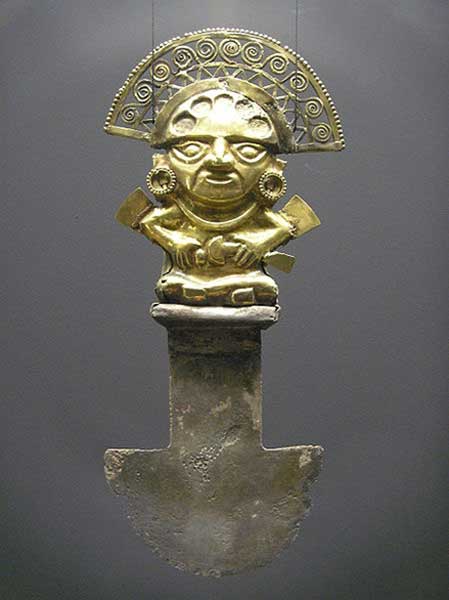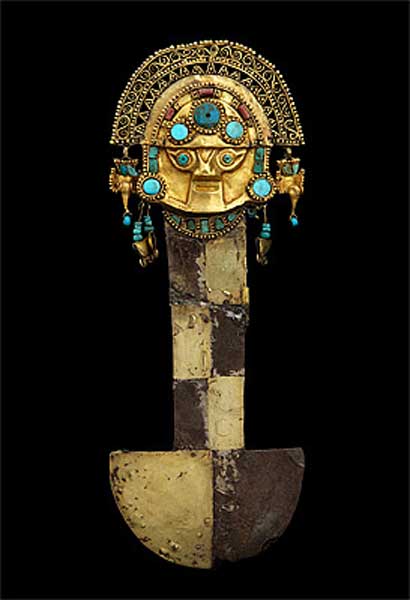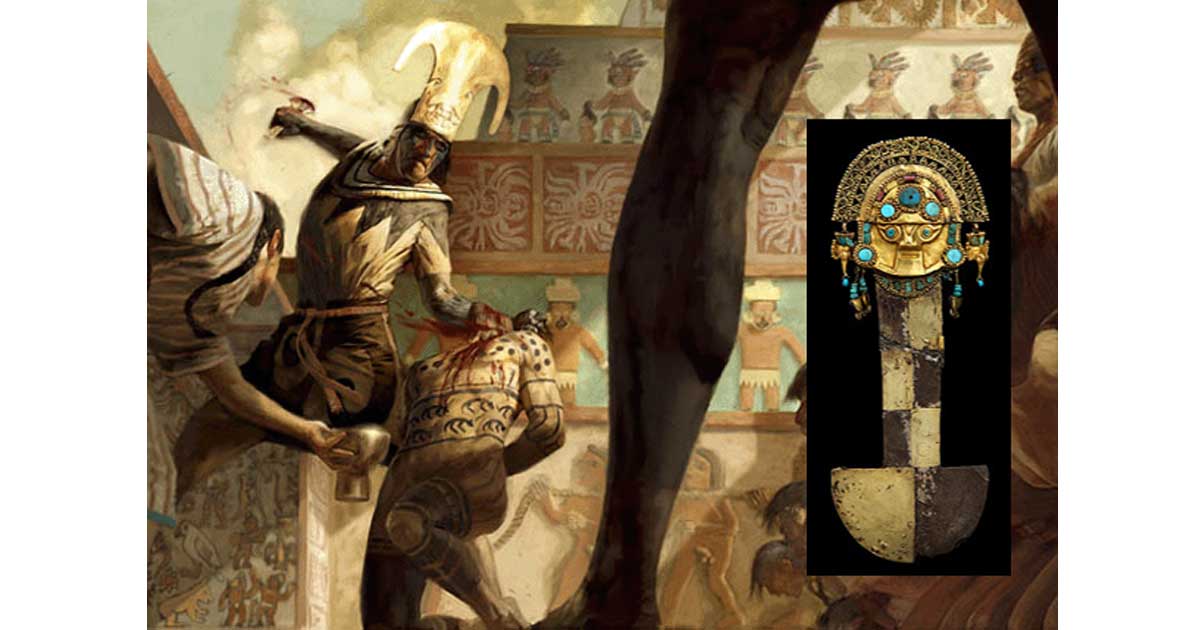By the Cut of a Tumi: An Iconic Ceremonial Artifact of Ancient Peru
The tumi was a ceremonial knife used by several pre-Columbian cultures that inhabited the Peruvian coast, including the Moche, Sicán, Chimu, and Inca cultures, to carry out blood sacrifice and perform surgical procedures.
This artifact is easily recognized due to its semi-circular blade. In addition, its handle may also be quite distinct, as it is often sculpted with an animal or human effigy. As a ceremonial object, tumis were often made using a type of precious metal. These include gold, silver, copper, and bronze.

A tumi from Sipán, Peru. 850-1050 AD. The golden effigy depicts a richly decorated dignitary, possibly a priest, who is also holding a sacrificial knife in his hand. The earlobes once had turquoise inlaid in them. The back of this tumi is decorated with tear-shaped gold leaf. (Public Domain)
The Origins of the Tumi
The origins of the tumi is found in the Moche culture. According to one source, the word ‘tumi’ is derived from the language of the Moche people. Based on oral tradition, the Moche are said to have been navigating along the Chancay River in order to find a suitable place to settle down. Whilst they were travelling along the river, they spotted some sea lions on a shore. They took this as a divine sign, and decided to make their home there. Apparently in their language the word for sea lion was ‘tumi’. As these sea lions were regarded as a sign form the gods, the word ‘tumi’ took on a divine association from then on.
- Hundreds of Ancient Mummies Discovered at Ceremonial Site in Peru
- Chancay Burial Dolls: Ancient Peruvian Grave Goods of a Lost Culture
- Cloud Warriors: The Mysterious Power of the Lost Chachapoya Culture
Ceramic vessel representing a ‘caballito de totora’ and a Chimú fisherman. (Luis García/CC BY SA 3.0) This type of reed watercraft has been used by fishermen in Peru for the past 3000 years.
A Ceremonial Artifact
When the Moche began performing human sacrifices, the daggers that were used become known as tumis as well. It was believed that sacrifices had to be performed in order to please the gods. As a result, the sacrifices took on a sacred aspect, and it is not surprising that the knives they used had a name that was connected with the divine. The tumi often appears in Moche iconography, and is shown to be used to slit the throats of sacrificial victims.
Whilst the Moche culture eventually came to an end, the tumi survived. This ceremonial knife was adopted by the Sicán culture which succeeded the Moche people. It was during this period that the handle of the tumi acquired its unique design. During the Moche era, tumis had plain handles. This changed when the Sicán leaders came to power. The founder of the Sicán culture was a man by the name of Naylamp.
Legends say that when Naylamp died, wings grew out of his back and the dead ruler awoke and flew to heaven. As a result of this, the Sicán created the image of the birdman to memorialize their founder. It seems that at some point of time, a Sicán priest decided to attach a figure of the birdman onto his tumi.
- Grave Goods and Human Sacrifices: Social Differentiation in Sican Culture Reflected in Unique Burials
- Did Ancient Priests in Peru Invent Authority?
- Sex Pottery of Peru: Moche Ceramics Shed Light on Ancient Sexuality
In addition, prior to Naylamp’s death, a cult of the ruler was established, as he had built a great temple, in which a jade figure representing himself was placed on a pedestal. The memory of this cult figure, known as the ‘Yampallec’, is cited as the reason for the insertion of jade pieces on handles of the tumis.

This tumi’s silver blade was covered with sections of gold foil and topped with a representation of Naylamp. (National Gallery of Australia)
Ancient Surgeries and Modern Discoveries
Apart from ritual sacrifices, the tumi was also used for surgical purposes, more specifically, for trephination, a form of surgery in which a hole is drilled / scraped into the skull. This type of surgery was performed by Incan surgeons in order to provide relieve to patients suffering from inflammation due to head trauma. Unlike the ceremonial tumis, these surgical blades were smaller.
In 2006, it was reported that a trove of pre-Incan artifacts was discovered by archaeologists excavating a group of graves in northern Peru. Amongst these were the first tumis retrieved by archaeologists during an excavation.

A selection of tumis. (SFU Museum of Archaeology and Ethnology)
Prior to this discovery, tumis came into the hands of archaeologists via grave robbers. Thus, this find is important, as it allowed archaeologists to study the ceremonial knives in a context, which in turn would allow them to obtain a greater understanding of their cultural significance.
Today, the tumi has become a popular Peruvian icon, and it is said to embody what it means to be Peruvian for many people.
Top Image: Moche Sacrifice Illustration. (Anthropology.net) and tumi’s silver blade was covered with sections of gold foil and topped with a representation of Naylamp. (National Gallery of Australia)
By Wu Mingren
References
Cyber Museum of Neurosurgery, 2016. Pre-Columbian Trephination. [Online]
Available at: http://www.neurosurgery.org/Cybermuseum/pre20th/treph/trephination.html
Discover Peru, 2016. Tumi, the ceremonial knife. [Online]
Available at: http://www.discover-peru.org/tumi-knife-culture/
Mejia, M., 2006. Dig uncovers ancient Peruvian knives. [Online]
Available at: http://www.nbcnews.com/id/15841249/ns/technology_and_science-science/t/dig-uncovers-ancient-peruvian-knives/#.V719Wvl97cd
The Metropolitan Museum of Art, 2016. Ceremonial Knife (Tumi). [Online]
Available at: http://www.metmuseum.org/toah/works-of-art/1974.271.60/
Vasquez, P. M., 2016. The Tumi: Facts, History and the Origin Behind Peru’s Most Famous Art Work. [Online]
Available at: http://xpatnation.com/the-tumi-facts-history-and-the-origin-behind-perus-most-famous-art-work/




















